- India and Iran have had long and close cultural links. Their ancient and modern histories have been
intertwined. - The relations between India and Iran go back to the ancient civilizations of the Indus valley and Mesopotamia. There was trade between the coast of southern Iran and India through the Persian Gulf and the Arabian Sea. Some Indus seals have been excavated at Kish, Susa, and Ur in Iran.
- The Harappan people are believed to have imported silver, copper, turquoise, and lapis lazuli from Persia and Afghanistan. Iran supplied silver, gold, lead, zinc, and turquoise to ancient India. Ivory was imported from India.
- Since India’s independence, the relations have been essentially peaceful, friendly and emphatic.
- The two countries shared a border till 1947 and share several common features in their language, culture and traditions. India and Iran established diplomatic links on March 15, 1950.
- In 1953, Iran was ruled under Shah Mohammad Reza Pahlavi. During much of the Cold War period, relations between the India and the Iran suffered due to different political interests, primarily due to non- aligned tactic of India towards the US, which enjoyed close ties with the Iran. Also India was leaning more towards USSR, especially after the conclusion of Treaty Of Peace and Friendship in 1971
- India-lran Relations have turned more fruitful and productive after the Iranian revolution of 1979, the war in Afghanistan (1979) and the Iran-Pakistan ties got degraded.
- After Cold War, relations have been improving. Iran and India closely cooperated in supporting the Northern Alliance in Afghanistan against the Taliban in the 1990s.
- Iran has emerged as India’s most viable transit option for trade with Central Asia and Russia. India, Russia and Iran signed an agreement in 2000 for sending Indian Cargo to Russia via Iran through a ‘North-South Corridor’.
- The “Tehran Declaration” signed during former Prime Minister Atal Bihari Vajpayee’s visit to Iran affirmed the shared vision of the two countries for an “equitable, pluralistic and co-operative international order”. It recognized the then Iranian President Mohammad Khatami’s vision of a “dialogue among civilisations” as a paradigm of international relations based on principles of tolerance, pluralism and respect for diversity.
- But in 2006, India voted against Iran over its clandestine nuclear programme at International Atomic Energy Agency. Due to US pressure India slashed Oil imports by 40 percent and backed off from pipeline project bringing gas via Pakistan. This was a huge setback to India-Iran relations. However, relations were back on track in 2008 when Iranian President Mahmoud Ahmadinejad came to India, and India promised an independent policy towards Iran and not yield to US pressure.
- India has worked hard to maintain its ties with Iran when there were international sanctions on Iran from all sides. Bilateral trade with Iran suffered due to banking and insurance censures.
- In 2015, India liberalized its visa policy for Iran and struck it off the prior referral category (PRC) of countries. Iran can be the key supporter of India in the wake of the growing influence of terror groups such as the Islamic State.
- Prime Minister Modi’s historic visit to Iran in 2016 led to enhanced focus on increasing connectivity, trade, investment and enegy partnership. India, Afghanistan and Iran signed a trilateral trade treaty for developing the port project and beyond.
- In April 2016, India’s Minister of State for Petroleum and Natural Gas visited Iran. India and Iran sealed the terms to develop the gas project Farzad B in the Persian Gulf.
- Farzad-B field was discovered by Indian explorers in 2012.
- India lined up USD 20 billion as investment in oil & gas, petrochemical and fertilizer projects in Iran. In May 2016, PM Modi visited to Iran, where the historic Chabahar port agreement was signed which is a contract for the development and operation of the port for 10 years of 2 terminals and 5 berths. There was a MoU on provision of services by Indian Railways, including financing $1.6 billion, for Chabahar-Zahedan railway line.
- India will invest in setting up industries from aluminum to urea plants in Chabahar.
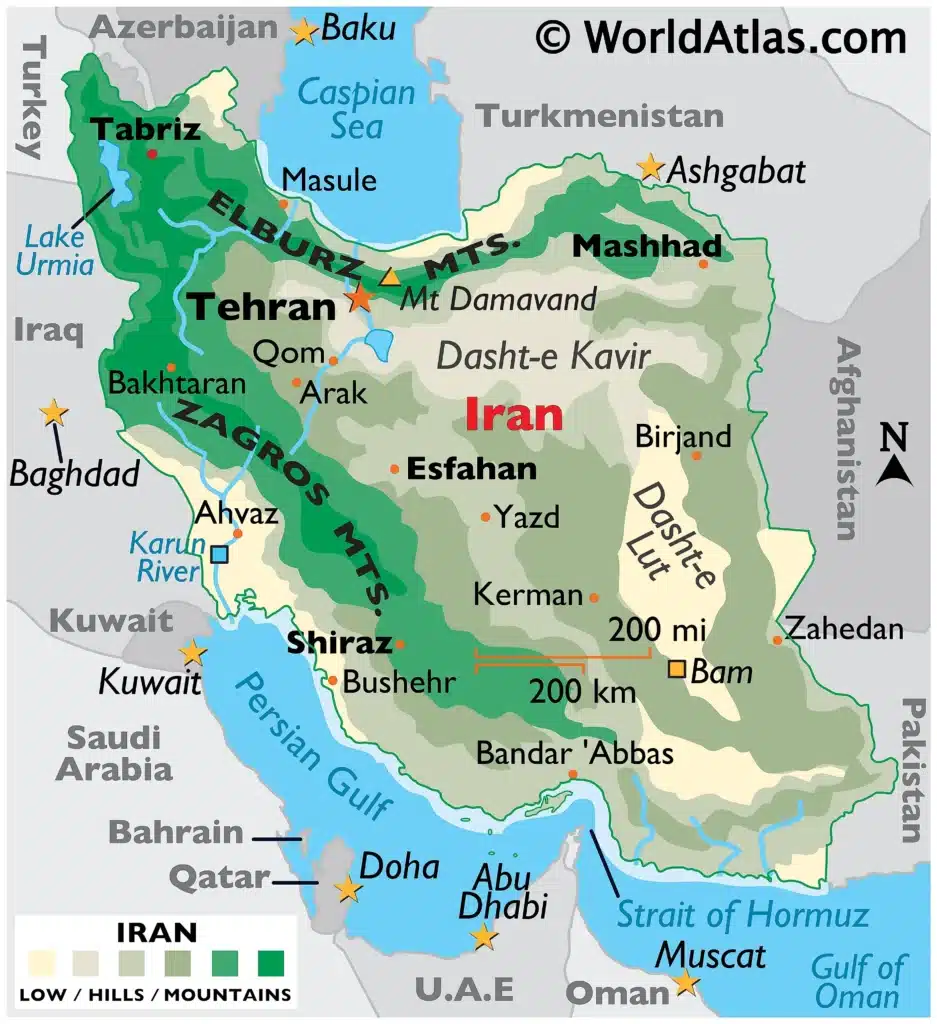
Areas of Cooperation
Political
- India-lran relations span millennia marked by meaningful interactions. Independent India and Iran established diplomatic links on March 15, 1950.
- After the Iranian Revolution, Prime Minister Narasimha Rao visited Iran in 1993 and President Rafsanjani paid a visit to India in 1995.
- The trend was enhanced at the turn of the millennium with the visit of Prime Minister Shri Atal Bihari Vajpayee to Tehran in April 2001, wherein the two countries signed the ‘Tehran Declaration‘ which set forth the areas of possible cooperation between the two countries.
- The New Delhi Declaration’ set forth the vision of strategic partnership between India and Iran. Prime Minister Dr. Manmohan Singh visited Iran to attend the 16th ‘Non Aligned Movement’ (NAM) Summit held in Tehran from August 28-31, 2012.
- Indian Prime Minister Narendra Modi visited Iran in 2016. Both the countries released a joint statement titled “Civilizational connect, contemporary context”. Also, the contract on Chabahar was signed.
- Iranian President Dr. Hassan Rouhani’s Visit to India (2018)
- Nine agreements were signed with focus on Iran’s Chabahar port.
- Agreements were on issues of Avoidance of Double Taxation, easing visa norms, instrument of ratification of extradition treaty, cooperation in the field of Traditional Systems of Medicine and lease contract for Shahid Beheshti Port – Phase 1 of Chabahar.
- Joint Statement titled “Towards prosperity through greater connectivity” was released.
- The Foreign Minister of Iran visited India for the first time since the new government was formed in 2021. The visit was in alignment with the “Asia-oriented” foreign policy of the new Iranian government.
Trade Relations
- India-lran commercial ties have traditionally been dominated by Indian import of Iranian crude oil.
- India was the second largest buyer of Iranian crude after China and Iran was the 2nd largest supplier of crude to India (April-June 2018).
- The India-lran bilateral trade during the fiscal year 2016-17 was USD 12.89 billion.
- India imported USD 10.5 billion worth of goods dominated by crude oil and exported commodities worth USD 2.4 billion.
- Major Indian exports to Iran include rice, tea, iron and steel, organic chemicals, metals, electrical machinery, drugs/pharmaceuticals, etc.
- Major Indian imports from Iran include petroleum and its products, semiprecious stones, etc.
- In 2018-2019, India imported crude oil worth US$ 12.11 Billion. This is due to the ‘Significant Reductions Exceptions’ waiver from the US coming to an end. Under ‘Significant Reductions Exceptions’ the USA permitted India and a few other nations to continue importing crude oil from Iran, without any sanctions.
- Despite all these sanctions, to get around the US sanctions, the Reserve Bank of India and the Iranian Central Bank signed a ‘Currency Swap Agreement’ which permits India to pay for the oil imports from Iran using the Indian Rupee (INR). This would save India its precious foreign exchange reserves.
Energy Security
- Iran is India’s core energy partner. India is also negotiating a contract on Farzad B gas field. A team of OVL (ONGC Videsh Ltd) visited Iran from December 5-6, 2016 to continue discussions on the Farzad B gas field contract. However, the negotiations have been time consuming.
- Indian firms are willing to invest upto $20 billion in Iran’s energy sector and setup petrochemical and fertilizer plants in Chabahar Special Economic Zone.
- Iran has the world’s second-largest reserves of natural gas, yet it is not a major exporter.The proposed Iran-Oman-India undersea gas pipeline can help India move towards clean energy.
Cultural Relations and Diaspora
- An Indian Cultural Centre is currently functioning within the Embassy premises, and Iran has Cultural Centres in Delhi, Hyderabad and Mumbai.
- In 2016, MoUs on India-lran Cultural Exchange Programme, ICCR and ICRO of Iran, National Archives of India and the National Library and Archives Organisation of Iran, were signed along with establishing a chair for Hindi language in Tehran University and India-lran Eminent Persons Group.
- While there was a large Indian community in Iran during the Shah’s time, post Revolution this has dwindled, and there is now a small Indian community in Iran consisting of 80-100 families in Tehran and 13-15 families in Zahedan.
- According to a BBC World Service poll conducted at the end of 2005, 71 percent of Iranians regarded India’s effective feedback positively, with 21 percent viewing it negatively, giving India the most favourable rating of any country in the world.
Connectivity
- Infrastructure projects like Chahbahar Port, International North South Transport Corridor will help India to bypass the overland route through Pakistan and help in better trade relations with West and Central Asia.
Chabahar Port
- The port of Chabahar is located in southeastern Iran in the Gulf of Oman.
- It is the only Iranian port with direct access to the ocean.
- It’s located in the Sistan-Balochistan province on the energy-rich Iran’s southern coast.
- The Chabahar port is considered a gateway to golden opportunities for trade by India, Iran and Afghanistan with central Asian countries.
- Significance:
- No other international port has seen the level of involvement and enthusiasm from Chabahar as India.
- It will make way for India to bypass Pakistan in transporting goods to Afghanistan using a sea-land route.
- At present, Pakistan does not allow India to transport its territory to Afghanistan.
- The distance between Kandla Port in Gujarat and Chabahar Port is less than the distance between Delhi and Mumbai. This highlights the cost and logistic advantage that India will enjoy in its trade with Iran, Afghanistan and other Central Asian countries.
- Chabahar port will be beneficial to India in countering Chinese presence in the Arabian Sea and having an eye on Chinese movements in the region. China is developing Gwadar port in Pakistan and Chinese submarines have also docked at the port. Gwadar port is less than 100 km from Chabahar by sea.
- Expansion of the port will bring more trade and development to ‘Sistan-Balochistan’, a strategic province for Iran as it borders Pakistan and Afghanistan, and has been restive. In recent years, the region has also witnessed an upsurge in terrorist attacks by groups based in Pakistan.
- Bandar Abbas port handles 85% of Iran’s seaborne trade and is highly congested. Unlike Bandar Abbas, Chabahar has the ability to handle cargo ships bigger than 100,000 tons.
- It would give momentum to the International North-South Transport Corridor of which both are initial signatories along with Russia.
- Iran is the key gateway to this project.
- It would counter the Chinese presence in the Arabian.
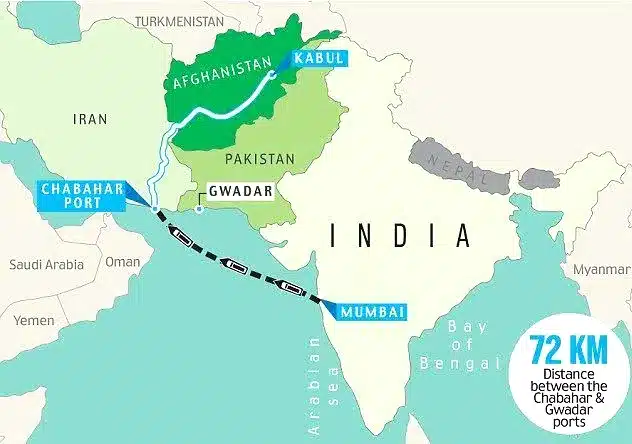
International North-South Transport Corridor (INSTC)
- The International North-South Transport Corridor (INSTC) project was originally decided between India, Iran, and Russia in 2000 in St Petersburg, and subsequently included 10 other central Asian and west Asian countries:
- Azerbaijan Armenia, Kazakhstan, Kyrgyz Republic, Tajikistan, Turkey, Ukraine, Belarus, Oman, Syria, and Bulgaria are observers.
- Pakistan, Turkmenistan and Afghanistan are not party to the INSTC agreement but are interested in using the transport corridor.
- It envisions a 7,200-km-long multi-mode network of ship, rail, and road routes for transporting freight, aimed at reducing the carriage cost between India and Russia by about 30% and bringing down the transit time from 40 days by more than half.
- The route primarily involves moving freight from India, Iran, Azerbaijan, and Russia.
- Objective:
- The objective of the corridor is to increase trade connectivity between major cities such as Mumbai, Moscow, Tehran, Baku, Astrakhan, etc.
- Significance:
- It would be provided as a viable and fairer alternative to China’s Belt and Road Initiative (BRI).
- Further, it will enhance regional connectivity.
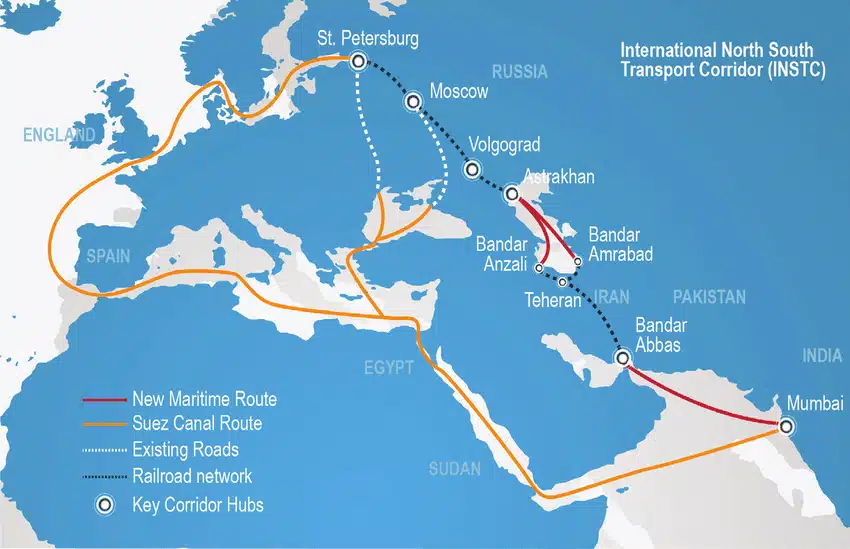
Terrorism/Security
- India and Iran both face the threat of terrorism by outfits like Al-Qaeda amd Islamic State.Hence counter terrorism
Significance of Iran to India
Iran is set to emerge as not only an important supplier of energy, but also as a key regional player in Central Asia and the Middle East.
Connectivity
- Iran is located at the crucial junction of South Asia and the Middle East. It also links the Central Asian Republics and the Caucasus region to the Arabian Sea. Therefore, the connectivity to Central Asian region through Iran has been a vital interest to India.
- Chabahar Port: India and Iran have also signed a deal to develop the Chabahar port in southern Iran. In the absence of a land route through Pakistan to Central Asia, a road and rail network via Chabahar port is important for India. It will open up a trade route to Central Asia and Afghanistan. India didn’t have this kind of access in the past. The Zaranj-Delaram road constructed by India in 2009 can give access to Afghanistan’s Garland Highway, setting up road access to four major cities in Afghanistan – Herat, Kandahar, Kabul and Mazar-eSharif.
- The successful inauguration of the Phase-1 of Chabahar Port in early December 2017; the ratification
of the Trilateral Agreement between India, Iran and Afghanistan on Establishment of International Transport and Transit Corridor by all sides; and the successful shipment of wheat assistance from India to Afghanistan through Chabahar Port have opened a new gateway to and from Afghanistan, Central Asia and beyond.
India’s Accession to Ashgabat Agreement
- Accession to the Ashgabat Agreement would enable India to utilise the existing transport and transit corridor to facilitate trade and commercial interaction with the Eurasian region.
- The Ashgabat agreement is a Multimodal transport agreement between Oman, Iran, Turkmenistan, Uzbekistan, Kazakhstan and Pakistan for creating an international transport and transit corridor facilitating transportation of goods between Central Asia and the Persian Gulf.
International North-South Transport Corridor (INSTC)
- This corridor (ship, rail and road route) connects India Ocean and Persian Gulf to the Caspian Sea via Islamic republic of Iran, and then is connected to St. Petersburg and North European via Russian Federation.
- Russia, Iran and India signed the agreement for the INSTC project in the year 2002.
- Iran is the key gateway in INSTC project. The objective of the corridor is to increase trade connectivity between major cities such as Mumbai, Moscow, Tehran, Baku, etc. Coupled with the Chabahar Port, INSTC can be the cornerstone of the India-lran relationship. The current members are India, Iran, Russia, Azerbaijan, Kazakhstan, Armenia, Belarus, Tajikistan, Kyrgyzstan, Oman, Syria, Turkey, Ukraine, and Bulgaria (observer).
- The successful activation of the corridor can reduce time and cost of container delivery by 30-40 per cent and will help connect India to Russia within 16-21 days.
- Turkey has offered to provide necessary information for linking Black Sea Economic Cooperation (BSEC) with INSTC.
- INSTC has the potential to serve as a strategic counterbalance to China’s One Belt, One-Road Initiative and allow India to integrate with Eurasian markets and firmly establish itself in Central Asian oil and gas production.
Kashmir Issue
- Iran’s membership at the Organization of Islamic conference (OIC) will link India to many of the Islamic countries. The OIC contact group on Jammu and Kashmir has time and again raised the Kashmir issue. India has said that the group (OIC) has no locus standi on India’s internal affairs and Iran considers Kashmir as a bilateral issue of India and Pakistan.
- However, recently Iran’s supreme leader, Ayatollah Khamenei, has reportedly mentioned Kashmir, equating the situation in the Indian state of Jammu and Kashmir with that of Yemen and Bahrain as requiring the support of “all Muslim nations”.
Afghanistan
- Presence of Taliban in Afghanistan and terrorists affiliated to al-Qaeda have jeopardized security of the Indian subcontinent. Thus, Iran’s cooperation becomes necessary to address the issue.
Market
- India is also Iran’s top rice supplier, and can move into exporting other agricultural products. Pharmaceutical is another area that India can capitalise on export gains.
India’s Energy Security
- In October 2016, Iran was India’s largest supplier of crude oil, with its exports to India exceeding the overall largest supplier Saudi Arabia’s exports of 697,000 barrels per day (bpd) by over 10%.
- India uses Iranian oil to expand its Strategic Petroleum Reserves (SPR) with a view to holding 90 days’ supply against contingencies.
- Farzad-B Gas Field Contract: India has been involved in Iran’s Farzad B gas field, where Indian companies explored and discovered oil and gas in 2008. The reserves of Farzad-B are said to be almost thrice the largest gas field in India.
- South Asia Gas Enterprise Pvt. Ltd. (SAGE): Negotiations are being held to build a $4.5 billion undersea gas pipeline from Iran to Indian west coast following India’s rejection of the proposal for an on-land pipeline that would pass through Pakistan. The planned pipeline from the Iranian coast via the Oman Sea and Indian Ocean to Gujarat is proposed to carry 31.5 million standard cubic meters gas per day.
Significance of India to Iran
- The influence of India at the international forums is growing; Iran needs India’s support at different forums for its cause. On UN sanctions against Iran, India said it would abide by any sanctions imposed by the Security Council on Iran, but indicated that it favoured the path of engagement with Iran. During the sanctions period, India continued low key commerce with Iran and purchased oil at lower volumes due to major problems in the payment procedure.
- Strategic location of India:
- Second largest populous country coupled with major economy and huge demographic dividend.
- It helps Iran to sell its oil to a large market, that’s near to its geographical location, which eventually reduces its cost.
- Improve Trade Ties: It gives Iran access to the 5th largest economy to invest in and enhance trade relations.it will also give fillip to Iran’s crippling economy.
- Stability of Afghanistan is a common interest of India and Iran.
Challenges in Relations
US Withdrawal from Iran Nuclear Deal
- United States withdrew from Iran Nuclear Deal in May 2018. This has potential negative impact on India Iran relations.
- The stoppage of oil imports from Iran after May 2019 owing to U.S. sanctions(CAATA) following the revocation of the Iran nuclear deal, therefore, impacting India’s energy security.
Oil Payment Row
- The problem arose in December 2010 when the Reserve Bank of India decided to no longer use a clearing mechanism to pay Iran for its crude oil.
- The use of Asian Clearing Union (ACU) currency swap system to pay Iran was stopped saying that this mechanism established at the initiative of the United Nations – United Nations Economic and Social Commission for Asia and Pacific (ESCAP) was disconcertingly opaque. Consequently, it was difficult to ascertain whether the money flowing into Iran’s coffers was not used to fortify the country ‘s nuclear programme.
- Faced with these objections, India began using the German bank, EIH, for making payments. However, this channel broke down in May 2011, after the European Union imposed sanctions on Iran. Because of the difficulties over payments, Indian companies accumulated a debt of nearly $5 billion.
- With the payment row festering, Iran decided to halt supplies to Indian firms. However, as the deadline for the payments neared, both sides scrambled to achieve a breakthrough. Later, it was reported that the payment row had been settled. India would pay part of the debt “promptly”, and the rest would be “gradually settled.”
- In February 2018 visit of Iran’s President, both the countries have agreed to set up a Joint Committee of officials to examine feasible options, including Rupee-Rial Arrangement, Asian Clearing Union mechanism to establish functional payment channels.
Iran-Pakistan-India Pipeline
- Iran-Pakistan-India (IPI) pipeline was envisaged to transport natural gas from South Pars gas field of Iran to Pakistan and India with a carrying capacity of 60 million standard cubic meters per day, to be equally split between India and Pakistan. The on land IPI pipeline has not taken off despite negotiations since 1995. India withdrew from the project in 2009 over security issues, gas pricing and gas volumes. However, sanctions imposed on Iran is also given as a reason. However, India and Iran are under negotiation over underwater gas pipeline (SAGE) bypassing Pakistan.
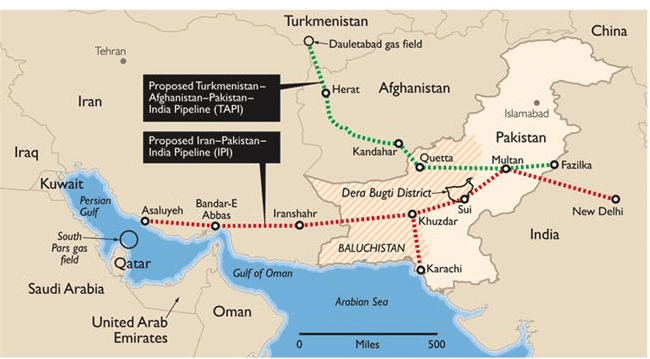
Saudi Arabia-lran-lndia
- The competition between Iran and the Saudi-aligned Gulf states is a dilemma for India, because it has deep interests on both sides of the divide. Trade is the first among these. A direct conflict between Iran and Saudi Arabia could shatter these ties, in part by cutting off the shipping lanes on which regional trade depends. India would suffer by backing either side.
- India’s massive diaspora (remittances) in the Gulf is another reason that it cannot afford a conflagration in the Middle East. Together with gas, oil is crucial to India’s drive to modernize its military and increase its wealth.
- Iran-backed Houthis in Yemen launching drone attacks against Saudi Arabia and UAE, both are close partners of India.
Chhabahar Railway Project
- The termination of Indian participation in the Chhabahar Railway Project. Iran has decided to proceed with the Chabahar rail line construction on its own, citing delays from the Indian side in beginning and funding the project.
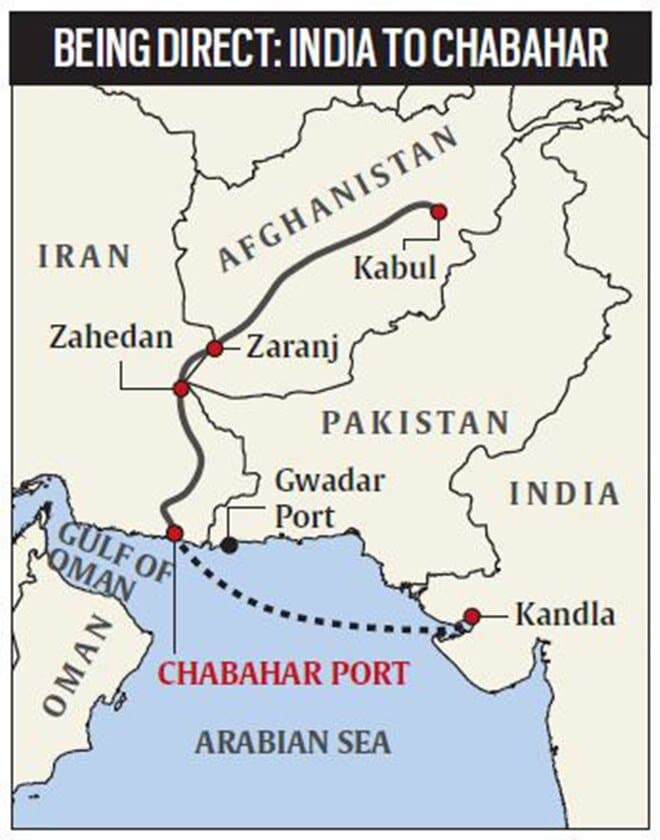
Farzad-B Gas Field:
- India’s ONGC Videsh Limited played a crucial role in discovering the potential of Farzad B gas fields in Iran in 2008.
- Despite 10 years of discovery ,Iran has not given the rights to develop the gas field to ONGC Videsh Limited. Rather it has signed an initial pact with Russia’s Gazprom for the purpose.
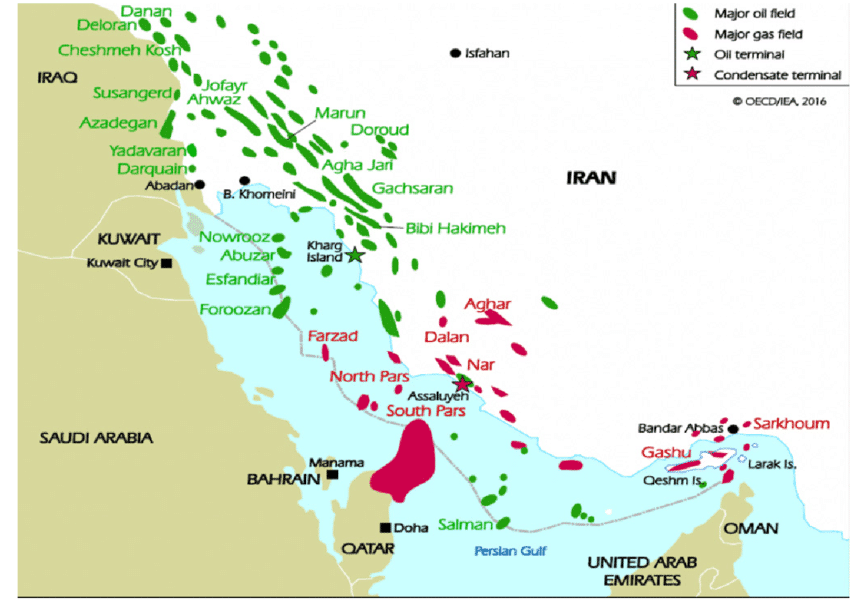
Iran-lsrael-lndia
- Israel slammed Iran nuclear deal saying it as a “historic mistake”. Both the nations are of interest to India and the challenge is to maintain balance in ties with Iran and Israel.
- India’s close relations with Israel, and Iran’s ties with China, including signing a 25-year strategic partnership agreement.
Iran’s Proximity to China
- Iran is a part of China’s ambitious Belt And Road initiative. This might come in conflict with India’s interests in Iran ,considering the fact that India has been vociferously opposing China’s Belt and Road Initiative.
Kashmir Issue
- On the issue of Kashmir, Iran has been a vocal supporter of Pakistan’s stand on Kashmir.
- Iran’s tough statement on the Indian government’s abrogation of Article 370 of the Indian Constitution, gave special status to Kashmir.
- Iran’s previous regime had on a couple of occasions made statements instigating the Muslims of Kashmir against the governance which was reprimanded by India severely.
Areas of Convergence
- Afghanistan:
- The Taliban government has largely been isolated since it took over Kabul in August 2021. Iran was one of the few countries that did not withdraw its embassy from Kabul and has continued to keep its channels of communication open with the Taliban.
- India is now keen to open back its embassy in Kabul and recently started negotiations with the Taliban.
- India and Iran have the potential to forge a common and effective policy of engagement with Afghanistan in the future.
- West Asia:
- There is rebalancing taking shape in the West Asian region this offers great potential to strengthen India-Iran ties.
- For a long time, India’s growing ties with the Gulf countries, especially Saudi Arabia and the UAE were seen as a “zero-sum game” pitted against their rivalry with Iran.
- The UAE and Qatar recently held good talks with Iran. Iranian President has already visited Qatar and Oman this year.
- Syria and Iraq are slowly consolidating and are positively disposed toward Iran.
- The Abraham Accords signed with Israel give hope towards the acceptance of Israel by the regional countries as a potential partner and not necessarily a foe.
- All these developments work well for India, as it has close and good relations with the Gulf countries, Iran, and Israel.
- This gives India the tremendous opportunity to develop and scale up its cooperation with Iran without fear of losing out on other friends in the region.
- In fact, at some point in time, India may emerge as the perfect interlocutor in the region, as it has the trust and confidence of all stakeholders.
Way Forward
- There is a need to look forward toward areas of convergence, where both countries have a mutual understanding of each other’s common interests and further work together to achieve the same.
- India and Iran, therefore, have a lot that can be achieved together. The assertive diplomacy being practiced by India, emphasizing on standing by its neighbors and friends and focusing solely on fulfilling its national interests, is a refreshing change.
- If India can extend the same vision toward its engagement with Iran, it could open a huge potential for cooperation between these two great nations and civilizations. Time is therefore ripe for a reset.
- Alternate payment mode: Short term course can be developing alternate mode of payment to Iran and promoting flexibility in investment mode.
- Carrying out high level talks with US about the security and strategic concerns of India vis-àvis China.
- The near-term developments in its neighbourhood are a priority for Tehran even as India tries to find a balance with his stated preference to develop closer ties with both the U.S. and Israel.
- India and Iran are looking to swiftly conclude a preferential trade agreement and a bilateral investment treaty.
- Newly relaxed visa norms announced by Iran in addition to India’s proposal for Indian businesses to invest in rupees in Iran are all moves in the right direction. Nonetheless, they may be insufficient to cement commercial ties if USA sanctions do return.
- India should give its full support for the effective implementation of the JCPOA. Only successful implementation of the JCPOA over a period of time can create the political space for additional negotiations.
- Both the nations can take leverage of their historical and civilizational relations to steer ties so much. The visit proved to be a much-needed reality check to the India-Iran partnership
